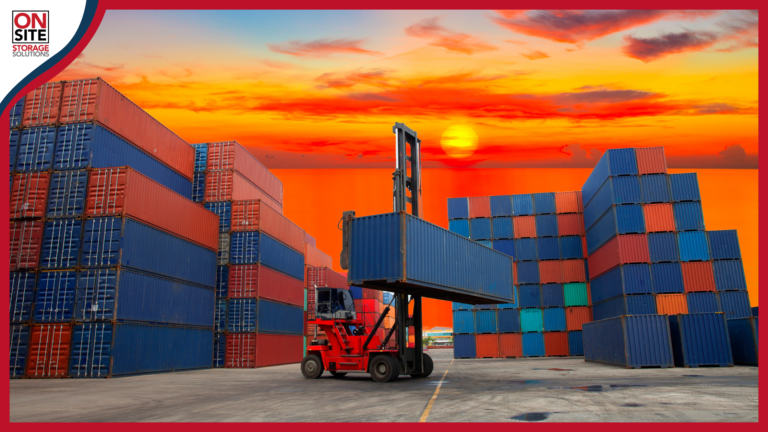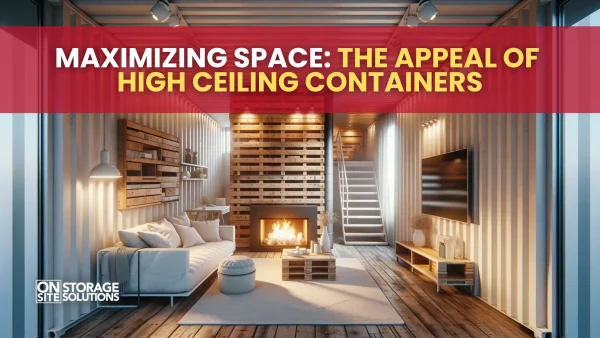
This guide will answer all of your questions regarding renting a storage container and help you make an informed decision about whether renting a storage container is right for you.
Table Of Contents
- Which is better for you- renting or buying a shipping container?
- How Much Does Renting a Storage Container Cost?
- Container Rental Periods
- Sizes of Shipping Containers
- Modifications And Accessories
- What Size of Container Should You Rent?
- Ensure That You Have All Necessary Documents and Permits
- Shipping Containers Stack vs Pods?
- Conclusion
Which is better for you- renting or buying a shipping container?
Many people wonder if they should rent or buy shipping containers. To make the best decision for you, consider these factors:
Cost of renting a storage container
The cost of renting a storage container is always going to be one of the main factors in your decision-making. First, it’s important to note that the monthly rental fees of a container versus a storage facility will typically be much less on a per-square-foot cost basis. Storage facilities will usually offer a 10-foot space and the price increases tremendously for a larger unit. The shipping containers are available in 20-foot and 40-foot sizes which is double to four times as much space for the same monthly cost. Second, figure out how long you’ll need the container.
If you are renting the container for 1-6 months it would be considered a short-term rental. In most cases renting a unit for a short term may not be cost-effective since you will be responsible for paying the delivery and pick-up fees as well. A long-term rental would be a time period of 6-12 months or more.
Typically, depending on delivery and pick-up fees, it will be more cost-effective to rent a unit rather than store your items in a rental facility for a year. It is highly recommended to contact a reputable container sales and rental company to get pricing for renting a container and the cost of delivery and pick up.
Note: Keep in mind that most container rental companies will require you to pay delivery and pick-up fees in advance as well as monthly rental fees. If you decide to purchase the rental container, the pick-up fee will be refunded or added to the payment of the container.
Convenience
The convenience of having the container on your own property and having it accessible to you at all times is an added advantage of container rental. This is contrary to most typical rental storage locations that have limited business hours and are located in industrial locations that require inconvenient travel time.
Container Condition
It is important to note that most container rentals are used shipping containers that have been retired from the shipping lines. Although they are guaranteed to be wind and water-tight and will protect your items, most have not been repainted and will have the original paint and ship line markings. If the appearance of the container is important to you then it’s important to request an upgraded painted container.
Which is better for you- renting or buying a shipping container?
The 20’ and 40’ shipping containers are the most common sizes. On average, it costs between $100 to $150 per month to rent a 20’ shipping container and $150 to $250 per month for a 40’ container.
The rental contract will also contain the transportation fees, which include the delivery and pick up of the container. Both of these are upfront costs that are paid prior to the delivery of the container. Delivery costs are based on a per-mile basis and in most cases there is a minimum fee which is typically $300 each way.
Size
The size of the container affects the cost of the monthly rental fee. The larger the container, the higher the monthly rate will be. However, the delivery and pick-up fees are usually the same for all sizes because it is priced per load. With this said, it’s important to note that you can load two 20 foot containers on a truck and pay one delivery fee as long as they are being delivered to the same location.
Age and Condition
Understanding the differences between container conditions and grades before renting one will give you the confidence that you are getting the right container for your needs.
There are three conditions: Used, Refurbished, and One Trip conditions. The condition of the container will directly influence the monthly rental price. The newer the container the more likely it is that you will pay a higher monthly rate. The One-Trip container is the newest container you can rent. A refurbished container is a retired wind and water-tight container that has been repaired and repainted. A used wind and water-tight container is a retired shipping container that has not been repainted and will have the original shipline markings. Each of these containers is guaranteed not to leak and is suitable for storage.
Related: Check out our guide on shipping container conditions and grades here.
Location and Delivery Cost
The cost of a shipping container is also determined by how far it must be transported from the depot to your location. The further you are from the depot, the more likely your delivery cost will increase. Most companies will have a minimum fee which is usually about $300. Before you decide to rent a container it is best to contact a reputable container company and inquire about the delivery cost upfront.

Container Rental Periods
You will most likely find that the longer you keep the container the less you’ll pay in monthly rental fees. This is why it is important to be realistic about how long you’ll actually need the container. Most companies will require you to sign a rental contract that is usually based on your desired rental period. There are monthly rentals available for 1 to 3 months. There are also container companies that provide savings if you agree to rent for 6 to 12 months. Depending on the agreement, you may renew and extend the period as desired.
Sizes of Shipping Containers
Depending on your needs, we have 20′ and 40′ shipping containers available. In terms of types, we have dry-van (Standard) and refrigerated (Reefers) containers. Please see this page if you’re unsure which size or type is appropriate for you. If you wish to inquire about our rental prices, please shop here.
What Size of Container Should You Rent?
Depending on your purpose for renting a shipping container, you must select the size of the container that best suits your needs. Whether you need extra area for :
Temporary storage space while remodeling your home. See our guide to determine whether you’ll need a 20’ or 40’ container.
- Creating a temporary office space for your job site – Usually, a 20-foot container will suit your office space needs.
- Storing building supplies or heavy equipment -we recommend renting a 40ft container so you’ll be able to move about freely as you load and unload the container.
- Cold storage needs – we recommend a refrigerated container which is typically available in a 40-foot size. You will very rarely get cost savings when renting a 20-foot refrigerated container because they are not commonly available.
Modifications And Accessories
Most shipping container rentals are dry van containers that are equipped with cargo doors on one end. However, if you need a modified container with roll-up doors, shelving, or security locking mechanisms you can surely make a request. Keep in mind that obtaining such modifications will often depend on the length of your contract. Most rental companies will be hesitant to make the investment in such modifications if the container will only be rented for a short-term. However, if you will be renting the container for at least a year, some companies may be willing to do the modifications for you.
Ensure That You Have All Necessary Documents and Permits

Before renting a shipping container for your business, double-check that you have all the correct documents and permissions to do so. Although it is a temporary structure, you’ll need to make sure you are allowed to set one on your property. Finding out ahead of time can save you money and undue stress. The permit requirements for a container will vary from location to location so it’s best to contact your local department that deals with permits.
If the container will be on your personal property or in a residential area it is important that you inquire about permits before getting the container delivered. This will protect you from possible costly fines. We also recommend that you inform your neighbors of your plans to rent a large container that may be considered an eyesore for some in the neighborhood. Getting buy-in from your neighbors or surrounding businesses is always the neighborly thing to do.
Ensure That Your Site is Large Enough and Can Meet Delivery Requirements
Finally, it is crucial to confirm that your location has the required space to fit your desired-sized container and that your site is prepped in advance to ensure a smooth delivery. For details on space requirements and site, readiness click here.
Shipping Containers vs Pods?
Shipping containers are frequently compared to pods. The similarities are that they are both self-contained containers suitable for storage. Pods are generally smaller units, typically 10 Foot boxes and they are not considered to be wind and watertight. Most consumers use pods for short term storage needs or for cross country moves because they are easily transportable. Shipping containers are larger, made of stainless steel, are considered wind and water tight and are generally better for long term storage needs because they can keep your items dry and keep the pests out.
FREQUENTLY ASKED QUESTIONS
The cost to rent a conex box ranges between $75 to $250 per month. It can vary depending on several factors, including the location, duration of rental, and size of the container.


























